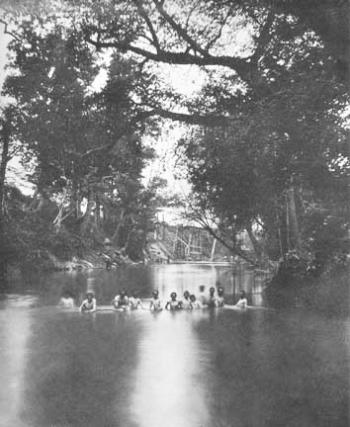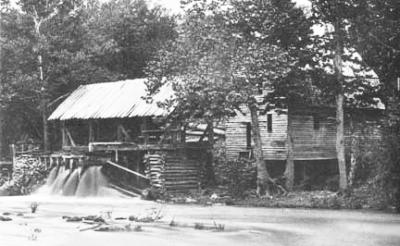The David Whitney Story
Part II – Chapter 5
David's Military Service
Section 7
The Overland Campaign – North Anna Riverand Totopotomoy Creek
Moving out of Spotsylvania
Following the fierce battles the previous week, the Union command decided to quit the positions facing the Confederate defense lines in Spottsylvania County and move on to the south—but to do so by circling to the east of the Mattaponi River in order to avoid having to cross its rain-swollen branches, the Ma, Ta, Po, and Ni lying directly in front of them.
As a diversionary measure, meant to draw Confederate forces out from their lines and across the Mattaponi tributaries, one Union corps was sent southeastward on the night of May 20th through the town of Bowling Green and on to Milford Station in Caroline County. The Union strategy depended on Confederate troops being slowed down as they slogged through the swollen streams and so becoming vulnerable to attack by the remaining Union forces.
The Confederates, however, did not take the bait and thwarted the Union attempt by sending a part of their army out to block the main highway south—Telegraph Road (today's U.S. Route 1, directly west of today's I-95 in Spotsylvania County)—thereby cutting off the direct route south and separating the Union's diversionary corps from the rest of the Union forces.
In response, the Union command had another corps withdraw from its position at Spotsylvania Court House and proceed to support the isolated diversionary corps. But chaos reigned, as this corps' advance was halted by the Confederate Troops on Telegraph Road and the diversionary corps was faced by supplemental Confederate troops that had been sent as reinforcements up from Richmond. Union forces then backtracked from their move southward on Telegraph Road and set off to follow the southeasterly route the diversionary unit had taken into Caroline County.
Redeploying to the North Anna
That night, Confederate forces completely left their positions at Spottsylvania Court House and moved further on towards Richmond to the south side of the North Anna River in Hanover County. They set up camp at Hanover Junction, site of the intersection of the Virginia Central Railroad into the Shenandoah Valley and the north-south Frederick, Richmond, and Potomac Railway. Their line of defense was arranged in the shape of an inverted V with the two sides of the V connected at the rear by the Virgina Central rail line.
On the next day, May 22, the Union command also moved their troops southward and encamped with two of their corps on the north side of the North Anna facing the right (eastern) flank of the Confederate lines. The Union's 5th Corps crossed the North Anna to the west and set up facing the Confederate left flank.
Union Troops Chilling in the North Anna

Image from Library of Congress Collection
North Anna
On May 24th, the 6th Corps, including David's 10th Vermont Regiment, also crossed the North Anna and took a temporary position to the rear of the 5th Corps. They moved that night, in the midst of a heavy rainstorm, out to Quarles Mill, where they engaged the Confederate picket line in a brief skirmish

Image from Library of Congress Collection
Quarles Mill
The next morning, the 6th Corps resumed the march and reached a railroad station, which they burned and then destroyed eight miles of track. That night the 10th Regiment was assigned to picket duty south of the station, but in such a wet place that the troops piled up fence rails to be able to sleep above the water.
On May 26th, after several attempts to breach the Confederate lines, the Union command realized that their opponents' defense was well entdrenched and insuperable at this location. Deciding to pull out and move on again toward Richmond, Union forces again staged a diversionary movement, this time by a cavalry unit flanking the Confederate lines to the west.
Unlike at Spotsylvania, this diversion worked, allowing the rest of the Union forces to move to the southeast along the Pamunkey River to a position much nearer the Confederate capital city, on its east side. The 6th Corps retraced their steps back across the North Anna and joined the movement along the Pamunkey.
Totopotomoy Creek
As Union forces were moving along the north side of the Pamunkey, Confederate forces also moved south towards Richmond but then stopped and entrenched at Totopotomoy Creek. The Confederate defense had been weakened, however, by a shortage of supplies due to the destruction of a portion of the Virginia Central railroad in which David and his comrades of the 10th Regiment had played a part.
On May 29th, the Union command probed the Confederate defenses with infantry units from three of its corps while the 6th Corps was continuing down the Pamunkey toward Hanover Court House from its position to the rear.
The following morning, the 6th Corps was ordered to turn south to support the Union right flank in an assault at Totopotomoy Creek but got bogged down in heavy swamp and thick oak forest. Intense fighting ensued at Totopotomoy, and elements of the 6th Corps reached the battle only later in the afternoon.
On the night of May 31 to June 1, the 6th Corps was withdrawn from position and sent 15 miles further on to Cold Harbor. In this maneuver, a detail from David's regiment was left in position on picket until sunrise. Then, in an attempt to keep Confederate forces from pursuing them, the detail withdrew in a way that gave the impression they were being relieved by another unit. They joined up with the rest of the 10th Regiment at Cold Harbor later that day.
At Totopotomoy Creek, both sides incurred heavy casualties. The 10th Regiment was spared much loss, when once again, as a part of the 6th Corps, they were deployed mostly in supporting roles. But such was not the case at Cold Harbor or in other battles to come, where David and the 10th Vermont Regiment were at the forefront of some of the harshest combat of the war's last ten months.
©2007 by Thomas Lee Eichman. All rights reserved.